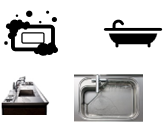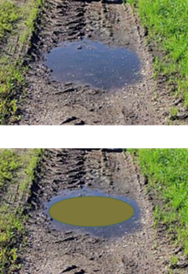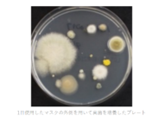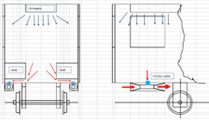Infection control measures that understands the properties of fine particles
Masami Otani
I have been proposing countermeasures for infection many times on the website of the Kyo-Suzume. Based on many years of experience in the semiconductor industry, the semiconductor industry is considered to be the most representative industry for controlling fine particles. We propose the properties of fine particles experienced in the semiconductor industry, control of fine particles, and removal of fine particles.
The 100nm size of COVID19 is the same as the particle control technology used when semiconductor manufacturing began 40 years ago. The measurement result of the number of particles from the floor surface was 300,000 particles in 1 cft (about 10,000 particles in 1 L). If the height is 86 cm or more, the count number will decrease.
As a countermeasure, there are guidelines such as hand washing, masks, and avoiding three-density, but there is no explanation as to why they should do so. There is no explanation from the media about the nature and movement of fine particles.
The website of the Kyo-Suzume has posted the history of infection control and infection from ancient times. I have summarized the contents so far, hoping to help prevent the spread of infection.
The infection in Japan started on passenger ships and houseboats, but what they have in common is the height above the floor where we live. If you encounter the position of the face and the height where the fine particles are floating for 15 minutes or more, the probability of encountering the fine particles and the infection rate will increase. It is necessary to take measures against the upflow of air conditioning related to seasonality.
In the manufacture of semiconductors and the development of semiconductor manufacturing equipment, the control of fine particles is the most important theme. The question is how to prevent it from being generated, whether to manufacture a semiconductor in a clean space from which particles have been removed, whether it is possible to remove fine particles without destroying the pattern in the unlikely event that fine particles adhere, and the development of cleaning methods and cleaning equipment. I would appreciate it if you could read the following.
Adhesion of fine particles
This is the reason for rubbing and washing hands for release fine particles.

- I think you experienced the adhesion of fine particles when cleaning the bathtub and sink.
- Rough matter as sticked something on the walls of bathtubs and sinks cannot be removed simply by pouring water tub.
- Generally, it is removed by rubbing with a sponge. Alternatively, it can be removed by rubbing it by hand. It can be removed by applying physical force.
- If fine particles adhere to an object, they will not separate unless physical force is applied. It is also attached and carried from overseas.
- Other than bringing it in directly by a person, it will be attached and carried. When physical force is applied, the attached fine particles adhere to the hand of the person who touched it by rubbing it with a hand or touching it, and the fine particles are repeatedly attached through the doorknob etc. touched by that person.
- Presence of fine particles
A lot of fine particles are floating on the bottom in water and within the height of the waist from the floor in the air.

Bottom: Mud flows up and becomes muddy |
|
About the properties and movement characteristics of fine particles
Keep the face position at 86 cm or more. Zashiki banquets have a high probability of infection.
・ I hope you understand the properties of fine particles.
- It will not separate from the adhering objects unless physical force works.
- Fine particles move between humans by rubbing, grasping, rubbing, or touching.
- Fine particles are suspended in the air layer within 86 cm from the floor unless the air flow is 0.11 m / s or more.
- Fine particles adhering to solids due to air flow do not separate even when air is blown at a speed of 137 km / h.

Bad Not good |

Better Not good |
About infection control that understands the properties of fine particles
The mask does not come into direct hands contact with the face and has the effect of reducing sputter.
・ Measures against infection of fine particles
- Avoid letting your face stay within 86 cm of the floor for more than 15 minutes.
- After touching, touching or squeezing an object, rub your hands and wash your hands.
- Avoid staying in areas where up flow is occurring as much as possible.
- Up flow occurs during the season when air conditioners for cooling / heating / floor warming / hot bumps are used. Fine particles are trapped in the diffusion of air.
- Wait for the natural death of fine particles attached to the solid matter. Do not use disinfectants as much as possible.
- Do not bring your hands close to your face. Masks are effective for this.
- The transmission size of the mask is 30 times that of 100㎚ fine particles.
・Disadvantages of masks
If you sweat especially in the summer and the mask gets damp, it will be in the same state as the mouth and nose are blocked, and it will be in a state of impermeable air. The news that a child collapses in the school playground during physical education is this phenomenon. The phenomenon of boiled frogs gradually causes dyspnea in the mask, and there is a risk of oxygen deficiency. It cannot arouse heat.
 This photo shows the germs of the mask left for one day and cultured. Hygienic management of masks is difficult, so care should be taken in managing masks, especially for children using masks.
This photo shows the germs of the mask left for one day and cultured. Hygienic management of masks is difficult, so care should be taken in managing masks, especially for children using masks.
Structure of a building that prevents fine particles and prevents infection
The positions of the air outlets and suction ports on the train have a reasonable positional relationship to reduce contact with fine particles.
I think we should consider that fine particles are floating in places where there is no air flow. This is a proposal example of a building that cures especially infected people who do not have an up flow that prevents them from being exposed to fine particles inside the building.
 |
 |
In the development of semiconductor manufacturing equipment
Factories that manufacture semiconductors and equipment that manufactures semiconductors are built on technology that controls particles.
Infection control is the same as semiconductor particle control.
・There are industries that avoid fine particles the most.
- Semiconductor manufacturing factory
- Semiconductor manufacturing equipment
・Semiconductor industry
- We are considering the air flow in the factory and equipment so that upflow does not occur.
- Consists of parts that do not extract fine particles so that fine particles do not occur.
- The air supplied to the factory and equipment is a ULPA filter (initially a HEPA filter), which can filter fine particles of 100㎚.
- There are many semiconductor factories in Wuhan, China, but the safest place when the corona occurred was inside the semiconductor factory.
- Just as the same phenomenon occurs in the sedimentation state of water pools on flat ground and water pools in high places, the same phenomenon occurs on the first floor and the top floor of high-rise buildings.
- The condition on each floor of the two-floor semiconductor factory is the same.
The end of document
